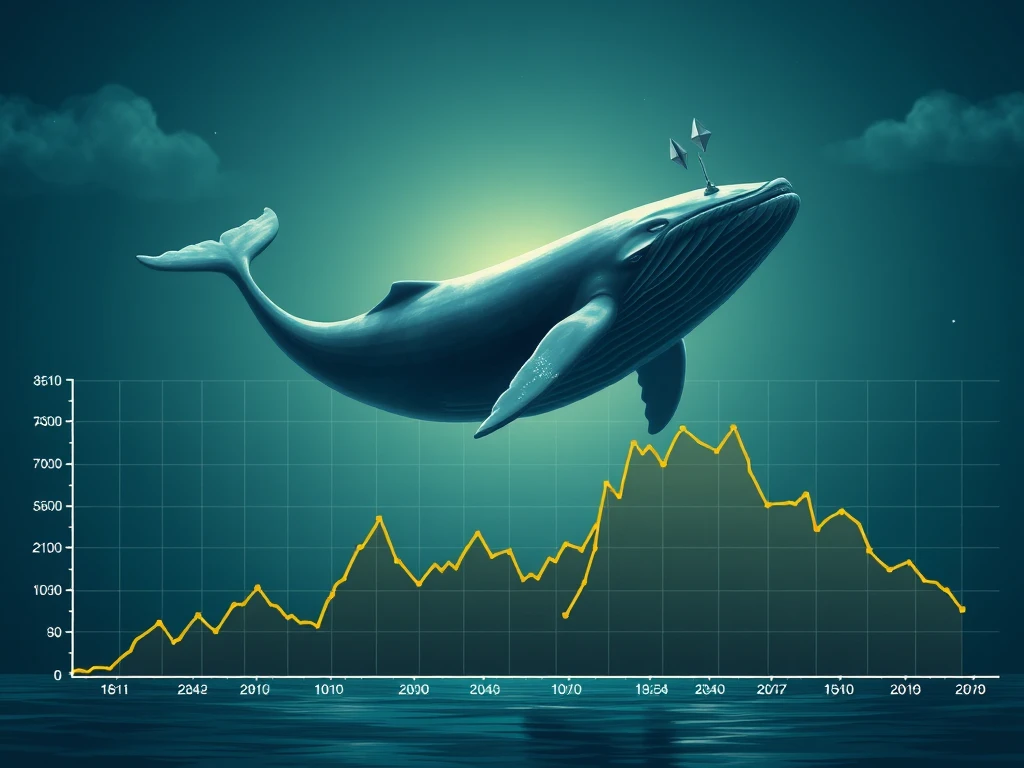Shocking Ethereum Whale Move: $27M Crypto Profit Lost After 900 Days

In the fast-paced world of cryptocurrency, even the savviest investors can miss out on massive gains. Recently, an Ethereum whale, a term for individuals or entities holding large amounts of cryptocurrency, made headlines for selling their entire ETH stash after holding it for 900 days. This move, while still resulting in profit, left a staggering $27 million potential profit on the table. Let’s dive into the details of this intriguing whale transaction and what it means for the broader crypto market.
Why Did This Ethereum Whale Sell Now?
According to blockchain analytics firm Lookonchain, this particular Ethereum whale initially accumulated 10,000 ETH in October and November 2022. Their entry price averaged around $1,295 per ETH, costing them a total of $13 million. Fast forward 900 days, and this whale decided to exit their position, selling their entire stack when ETH was priced at approximately $1,578. This sale resulted in a $2.75 million profit – not a bad return by any means. However, the crucial detail is that this whale missed the peak.
Key Points of the Whale’s Transaction:
- Initial Investment: 10,000 ETH purchased at an average of $1,295.
- Holding Period: 900 days.
- Selling Price: Approximately $1,578 per ETH.
- Realized Profit: $2.75 million.
- Missed Peak Profit: $27.6 million (at ETH’s peak of $4,015).
Imagine holding an asset that skyrockets in value, only to sell it before it hits its highest point. That’s precisely what happened here. The data from CoinGecko reveals that within this 900-day holding period, Ethereum reached a high of $4,015 on December 9th. Had the whale sold at this peak, their profit would have been a mind-blowing $27.6 million.
The Allure and Risk of Crypto Profit: Could Greed Play a Role?
The story of this Ethereum whale highlights a critical aspect of crypto trading: timing and the ever-present temptation of “what could have been.” Why didn’t this whale sell at the peak? Several factors could be at play:
- Market Volatility: The crypto market is notoriously volatile. Predicting the exact peak is incredibly challenging, even for seasoned traders.
- Trading Strategy: The whale might have had a pre-determined exit strategy, perhaps targeting a specific profit percentage or holding period, regardless of market peaks.
- Fear of Missing Out (FOMO) vs. Fear of Losing Profit (FOLP): While FOMO drives buying, FOLP can trigger premature selling. The whale might have feared a market downturn and decided to secure a profit, even if it meant missing a potential peak.
- Personal Circumstances: External factors unrelated to market analysis could have influenced the whale’s decision to sell at that particular moment.
This situation serves as a powerful reminder that in the quest for crypto profit, even substantial gains can feel bittersweet when juxtaposed with missed opportunities. It underscores the psychological aspect of trading, where emotions can often outweigh rational analysis.
Market Downturn and Whale Activity: What Else is Happening?
The timing of this ETH sell is also interesting considering the recent market downturn. Ethereum, like much of the crypto market, has experienced a dip, partly attributed to global economic factors such as potential tariffs. Currently trading around $1,426, ETH is down 24% over the past week. This broader market sell-off has triggered various reactions from other whales:
Whales in Action During the Downturn:
- World Liberty Financial (WLF) Sale: Lookonchain also reported that a wallet linked to the Donald Trump-backed crypto project, World Liberty Financial, may have sold 5,471 ETH at a loss, around $1,465 per ETH. This suggests even projects with significant holdings are reacting to market pressures.
- Dip Buying Whale: In contrast, another whale injected 10,000 ETH (over $14.5 million) to protect a massive 220,000 ETH position from liquidation, indicating some whales are seeing the dip as a buying opportunity.
- Liquidation Losses: However, not all whales are navigating the downturn successfully. One unfortunate whale faced liquidation of 67,570 ETH (around $106 million) on the Sky DeFi platform, highlighting the risks of leveraged positions in volatile markets.
Analyzing Whale Transactions: Insights for Crypto Investors
Tracking whale transactions provides valuable insights into market sentiment and potential future price movements. Large whale sells can sometimes trigger market dips due to increased selling pressure, while whale accumulation or dip-buying can signal potential bottoming out or bullish sentiment.
Key Takeaways from Whale Activity:
- Market Sentiment Indicator: Whale moves can reflect the overall confidence or fear in the market.
- Potential Price Impact: Large whale trades can influence short-term price fluctuations.
- Liquidity Insights: Monitoring whale wallets can offer clues about market liquidity and potential areas of support or resistance.
- Risk Management Lessons: The liquidated whale serves as a stark reminder of the risks associated with high leverage in crypto trading.
Navigating the Crypto Seas: Lessons from the Ethereum Whale
The tale of the Ethereum whale who missed a $27 million profit is a compelling narrative in the volatile world of cryptocurrency. It underscores the inherent challenges of timing the market peaks and troughs, even for large holders. While securing a $2.75 million profit is undoubtedly a success, the missed opportunity highlights the psychological pressures and uncertainties that permeate crypto trading. By observing whale transactions and understanding broader market downturn dynamics, investors can gain valuable perspectives to refine their own strategies and navigate the often turbulent crypto seas. Whether it’s learning from missed opportunities or heeding warnings from liquidation events, the actions of whales offer a continuous stream of lessons for all crypto market participants.









